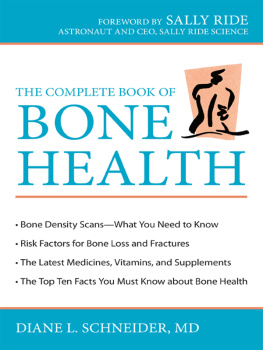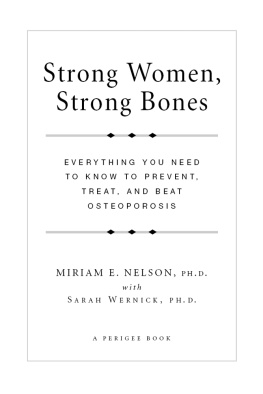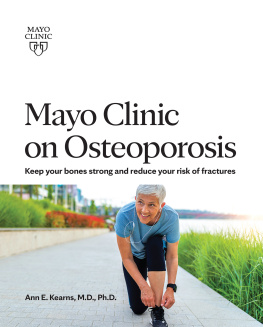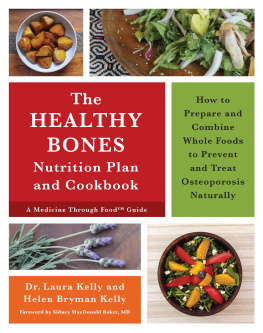
The Complete Book of Bone Health would not have been possible without the assistance of numerous individuals. Dr. Julie Silver, assistant professor at Harvard Medical School and chief editor of books at Harvard Health Publications, kickstarted the process. In October 2008, she taught me the nuts and bolts of publishing in her course called Medical Non-Fiction Writing for Physicians. As part of the same conference, which was produced by SEAK, Inc., I was fortunate to meet my agent Katharine Sands of Sarah Jane Freymann Literary Agency, who has shepherded me through the entire publication process. The hard work of editor-in-chief Steven L. Mitchell and his staff atPrometheus Books has made this up-to-date and evidence-based resource on bone health a reality.
I am especially grateful to Dr. Sally Ride for writing an insightful foreword. We share a vision of education for boosting bone health. Her endeavors through Sally Ride Science are inspiring and important for educating a new generation of girls and boys in the areas of science, math, and technology.
Friends, colleagues, and new friends gained in the process all contributed to the making of this book. Four readers were constantly ready at their computers to receive and review each chapter one by one. Dr. Mary Barry, Luanne Kittle, Sarah Wagner, and Joy Ward generously provided hours and hours of labor, advice, and encouragement. Talented Tim Gunther meticulously produced all the professional illustrations.
In an incredibly short period of time, professional editor Julie Ward exercised her skill to help me meet the word count. Sports journalist and author Jill Lieber Steeg edited line by line and did an incredible job of fact checking in a subject area far afield from sports. Julie and Amy Beattie painstakingly reviewed printed copies of the manuscript.
Numerous colleagues were generous with their time in taking my phone calls, e-mails, and questions. Special kudos are in order for Dr. Robert Heaney, Diane Claflin, Dr. Elliott Schwartz, Dr. Robert Marcus, Dr. Susan Lupo, Dr. Silvina Levis, Dr. Michael Kleerekoper, Dr. Vera Barile, Winnie Arnn, Peggy King, Janet Alexander, Dee Steinberg, and Dr. Elizabeth Barrett-Connor.
Last but most important has been the unwavering support and love provided by my husband, Dave Grundies, and my family.
Diane L. Schneider,
MD May 2011
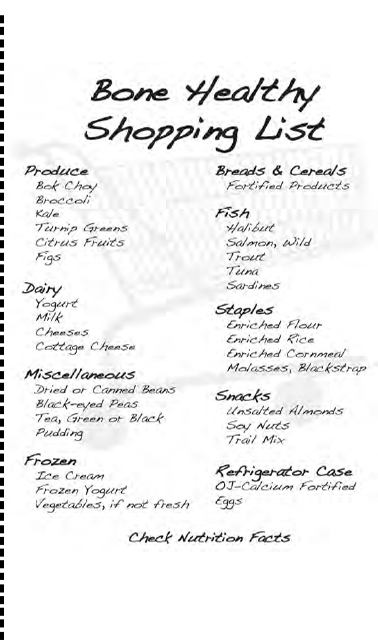

These are common words associated with bone health. If the word you are looking for is not listed, check the index for pages where you can find additional information.
Anabolics: medicines that turn on the bone-builder cells (osteoblasts) to promote formation of new bone. Forteo is the sole member of the anabolic group.
Antiresorptives: medicines that target the bone-breakdown cells (osteoclasts). These include the bisphosphonate class of medicines (Actonel, Atelvia, Boniva, Fosamax, generic alendronate, and Reclast), as well as calcitonin, estrogens, Evista, and Prolia. Decreasing bone breakdown results in slowing bone loss and improving bone density.
Bone Mineral: the crystalline component of bone made up of calcium and phosphorus in the form of hydroxyapatite.
BMD (Bone Mineral Density): bone mass is quantified by measurement of bone mineral. Bone mineral density predicts fracture risk.
Bone densitometry or bone density scan: the measurement of bone mass; the current gold standard device is the DXA machine, which quantifies bone mineral density of various skeletal sites, including the lower (lumbar) spine, hip, and forearm.
Bone scan: In contrast to a bone density scan, a bone scan is a nuclear medicine study. Any area of bone that has increased metabolic activity (fracture, tumor, or infection) will show increased uptake of the radioisotope.
Bone formation: the building of bone mass by cells called osteoblasts.
Bone remodeling: the continual process of bone-breakdown cells and bone-formation cells working in concert to keep bone repaired. An imbalance in bone remodeling causes problems. When bone breakdown exceeds new bone formation, such as with loss of estrogen in the menopause transition, bone loss occurs.
Bisphosphonates: synthetic compounds of the natural phosphorus that binds to the bone mineral. The name refers to the chemical structure of these phosphorus compounds: two phosphonate groups linked by a carbon atom. The structure of the side chains that branch from the carbon atom differentiates the various bisphosphonates. Fosamax, generic alendronate, Actonel, Atelvia, Boniva, and Reclast make up this class. Bisphosphonates block the breakdown of the bone by physically interfering with the bone-breakdown cells, or osteoclasts.
Cancellous bone: the spongy or trabecular bone tissue of the inner parts of the bones found in the vertebrae (spine), pelvis, and end sections of the long bones. This type of bone resembles a rigid sponge with a plate-like meshwork of beams. The plates within this kind of bone are called trabeculae. These act like cross braces that support and prevent collapse of the structure.
Compact bone or cortical bone: the hard, dense bone tissue of the shafts of the long bones of the arms and legs and the outer shell of all bones in the body. It comprises about 80 percent of the skeleton.
DXA (dual-energy x-ray absorptiometry): the full name is descriptive of the technique. The dual-energy x-ray part of the name accounts for the use of two different energy levels of x-ray. Absorptiometry refers to radiation passing through various body tissues that have different patterns of absorption. The differences in the two beams of radiation that pass through the body's tissues allow subtraction of the bone measurement from the measurement of the surrounding tissues. The results are usually reported as bone mineral density (BMD), which is a calculated measure in grams per square centimeter (g/cm2). Diagnosis is based on standardized T-scores or Z-scores, depending on age and sex.
Femoral neck or neck of femur: the narrowest portion of the hip; located between the femur's ball head and shaft. This area is a common site of hip fracture.
Femur: thighbone; the bone between the hip and knee joints.
Fracture: broken bone; the structural failure of bone.
FRAX: the fracture risk calculator developed by the World Health Organization. The FRAX tool incorporates results of the hip (femoral neck) bone density with personal risk factors to calculate your ten-year fracture probability. Treatment guidelines use the results of the ten-year probability of fracture for individuals with low bone mass or osteopenia.
Kyphoplasty: a technique for treatment of an acute painful spine fracture. A balloon is inflated inside the bone (vertebral body) to create a space and then cement is injected to stabilize the fracture.
NHANES (National Health and Nutrition Examination Survey): a program of studies designed to assess the health and nutritional status of adults and children in the US by studying representative samples from different parts of the country.
Nonvertebral fracture: a fracture that occurs in bones other than the spine.
Osteoblasts: cells that form new bone in the bone remodeling cycle.
Osteoclasts: cells that break down bone in the bone remodeling cycle.
Next page
